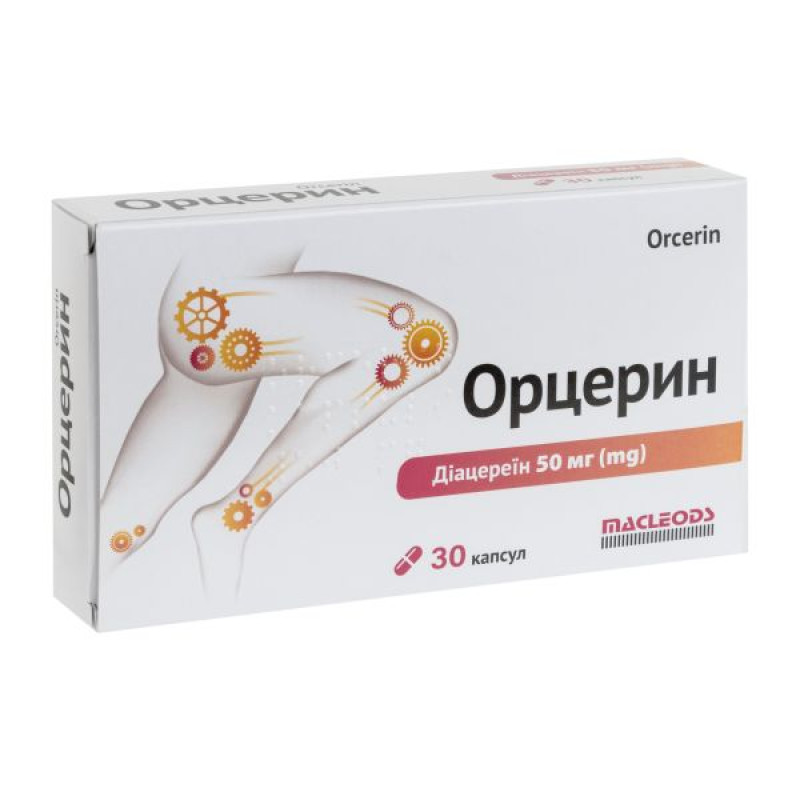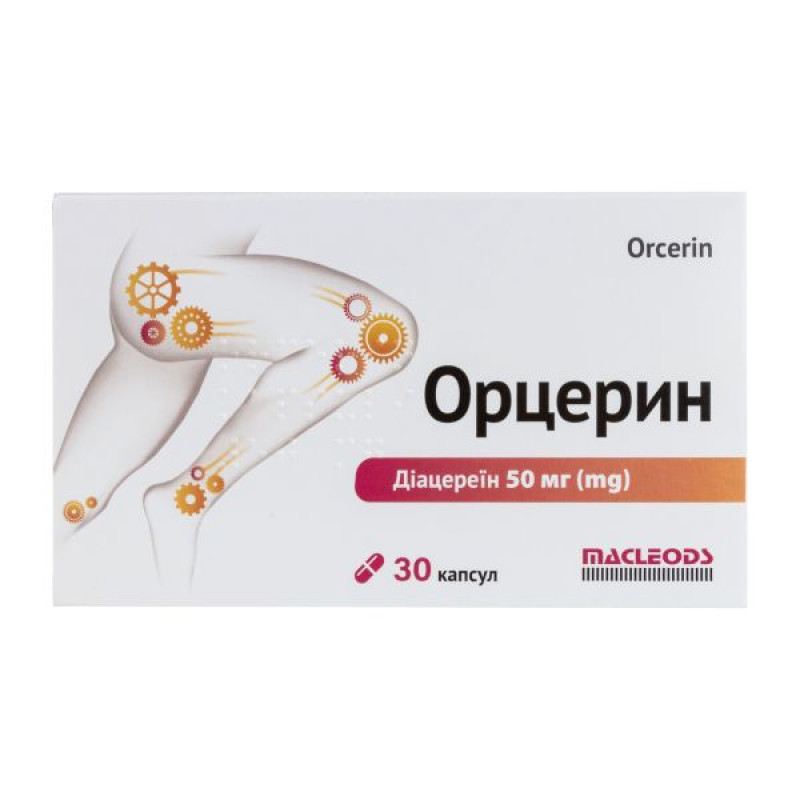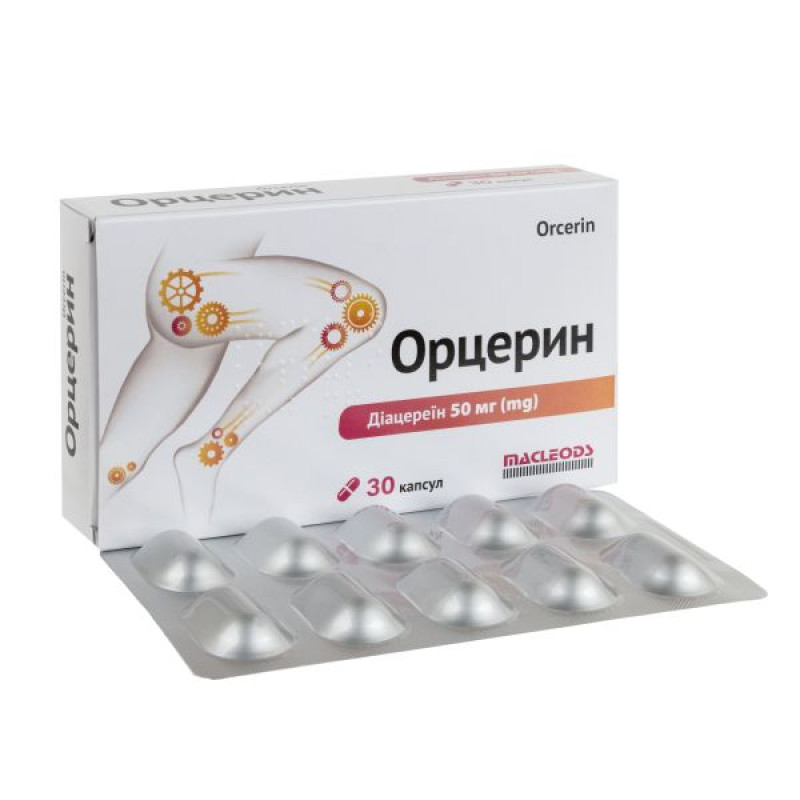Orcerin capsules 50 mg No. 30

Instructions for Orcerin capsules 50 mg No. 30
Composition
active ingredient: diacerein;
1 capsule contains diacerein 50 mg;
excipients: cyclodextrins, sodium lauryl sulfate, lactose monohydrate, croscarmellose sodium, colloidal anhydrous silicon dioxide, magnesium stearate;
capsule composition: diamond blue (E 133), ponceau 4R (E 124), quinoline yellow (E 104), titanium dioxide (E 171), sodium lauryl sulfate, methyl parahydroxybenzoate (E 218), propyl parahydroxybenzoate (E 216), gelatin.
Dosage form
Capsules.
Main physicochemical properties: hard gelatin capsules No. 1 with a blue body and a dark blue cap, containing light yellow powder.
Pharmacotherapeutic group
Nonsteroidal anti-inflammatory and antirheumatic drugs. ATC code M01A X21.
Pharmacological properties
Pharmacodynamics
Diacerein is a drug for the treatment of osteoarthritis, which has analgesic, antipyretic and anti-inflammatory properties. Diacerein is classified as a slow-acting agent, the effect of which is manifested within 2-4 weeks of treatment and reaches clinical significance after 4-6 weeks. It has an original mechanism of action, which differs from the mechanism of action of non-steroidal anti-inflammatory drugs (NSAIDs). Diacerein, like its active metabolite rhein, inhibits the synthesis and activity of interleukin-1 (IL-1), which plays a leading role in the pathogenesis of osteoarthritis and at the same time increases the production of transforming growth factor b (TGF-b), which initiates chondrocyte proliferation and stimulates the production of collagen II, proteoglycans and hyaluronan.
Unlike NSAIDs, diacerein does not inhibit prostaglandin synthesis and, therefore, has no gastroduodenal side effects.
Pharmacokinetics
The absorption of diacerein is slowed down when taken with food, which is also associated with an increase in the amount of absorbed substance by 25%. On the other hand, the occurrence of side effects, such as an increase in intestinal transit time, is directly related to the amount of unabsorbed diacerein, so the use of the drug on an empty stomach leads to an increased risk of side effects. Diacerein is completely converted to the rhein metabolite by deacetylation before entering the central circulation. The bioavailability of the rhein metabolite is 35-56%. The volume of distribution is approximately 13.2 l. The rhein metabolite is almost 99% bound to plasma proteins, but this connection is not stable. The rhein metabolite is either excreted unchanged by the kidneys (20%) or conjugated in the liver to rhein glucuronide (60%) or rhein sulfate (20%), which are also excreted in the urine. The half-life is approximately 7-8 hours.
No changes in the pharmacokinetic properties of diacerein were observed in elderly patients.
Indication
Treatment of patients with symptoms of osteoarthritis of the hip or knee, with a delayed effect.
Treatment with diacerein is not recommended for patients with rapidly progressive osteoarthritis of the hip, as they may have a poor response to diacerein.
Contraindication
History of hypersensitivity to the components of the drug or to anthraquinone derivatives.
Liver disease, present or history.
Inflammatory bowel diseases (nonspecific ulcerative colitis, Crohn's disease).
Intestinal obstruction or pseudo-obstruction.
Abdominal pain of unknown origin.
Pregnancy or breastfeeding.
Interaction with other medicinal products and other types of interactions
Taking diacerein can lead to diarrhea and hypokalemia. With simultaneous use of diacerein with diuretics (loop and thiazide) and/or cardiac glycosides (digitoxin, digoxin), the risk of arrhythmia increases.
Simultaneous administration with antacids (aluminum, calcium and magnesium salts such as oxides and hydroxides) significantly reduces the absorption of diacerein from the digestive tract. Therefore, there should be an interval of 1-2 hours between taking antacids and diacerein.
No interactions on plasma protein binding of rhein (the active metabolite of diacerein) were observed with warfarin, paracetamol, salicylic acid, indomethacin, ibuprofen, diclofenac, fenbufen, flurbiprofen, naproxen, phenylbutazone, piroxicam, sulindac, tenoxicam, sodium valproate, phenytoin, tolbutamide, glibenclamide or chlorpropamide.
Simultaneous use of diacerein and a blocker of H2-histamine receptors (cimetidine) does not lead to modification of the pharmacokinetic parameters of rhein in blood plasma and urine.
Application features
Diarrhea: Long-term use of diacerein can cause diarrhea, which can lead to dehydration and hypokalemia. If diarrhea occurs, treatment with diacerein should be discontinued and a doctor should be consulted regarding alternative treatment options.
It should be used with caution in patients taking diuretics due to the possible occurrence of dehydration and hypokalemia. Particular caution should also be exercised in the case of hypokalemia in patients receiving cardiac glycosides (digitoxin, digoxin) (see section "Interaction with other medicinal products and other types of interactions").
Hepatotoxicity. When using diacerein, an increase in serum liver enzyme levels and symptomatic acute liver damage are possible (see section "Adverse reactions").
Before starting treatment with diacerein, the patient should be asked about possible concomitant diseases, liver disease present or in history) and examined. Diagnosed liver disease is a contraindication to the use of diacerein (see section "Contraindications").
Monitoring for signs of liver damage is necessary during the first 2 months of treatment. Caution should also be exercised when using diacerein concomitantly with other drugs associated with possible liver damage. Patients should be advised to limit alcohol consumption during treatment with diacerein.
Treatment with diacerein should be discontinued if liver enzymes increase or signs of liver damage, including neurological symptoms, are detected. If symptoms of liver damage occur, a doctor should be consulted immediately.
Due to the late onset of action (after 2-4 weeks) of the drug, during the first month of treatment with diacerein, it can be combined with the use of nonsteroidal anti-inflammatory drugs and analgesics.
Diacerein metabolites can give urine a brown to red color depending on pH; this color change is of no clinical significance but may affect the results of colorimetric diagnostic tests (glucose dipsticks).
Since urine color may mask microscopic hematuria, laboratory tests of renal function, including urine sediment, should be performed regularly, especially if Orcerin is used for prolonged periods.
Orcerin capsules contain lactose. Patients with rare hereditary problems of galactose intolerance, the Lapp lactase deficiency or glucose-galactose malabsorption should not take Orcerin.
Use during pregnancy or breastfeeding
Due to lack of data, the use of Orcerin during pregnancy is contraindicated.
Diacerein should not be taken by women who are breastfeeding, as small amounts of the drug are found in breast milk.
Ability to influence reaction speed when driving vehicles or other mechanisms
There are no reports of the effect of diacerein on the ability to drive or operate other mechanisms.
Method of administration and doses
Treatment should only be initiated by physicians experienced in the treatment of osteoarthritis.
During the first 2-4 weeks of treatment, adults take 1 capsule (50 mg) with the evening meal, washed down with water. From the 2-4th week of treatment, the dose of the drug is increased to 100 mg per day in 2 doses (1 capsule in the morning and evening during meals). Diacerein has a slow, delayed initial activity and a residual effect after discontinuation of treatment, as a result of which Orcerin should be used for at least 2-4 weeks before the first positive effect appears. The positive symptomatic effect persists for 3 months after the period of use. Given the nature of the disease, a long course of treatment is recommended - at least 3 months, which can be repeated if symptoms appear.
The duration of the treatment course is determined by the doctor individually.
Elderly patients.
Diacerein is not recommended for patients over 65 years of age due to the fact that this category is more vulnerable to complications associated with diarrhea.
No significant changes in pharmacokinetic parameters have been observed when diacerein is administered to elderly patients, therefore there is no need to use the recommended dose (see section "Pharmacological properties"). However, caution is required when prescribing Orcerin to elderly patients. If diarrhea occurs, treatment with diacerein should be discontinued.
Patients with chronic renal failure.
Patients with mild to moderate renal impairment do not need to change the usual recommended dose. However, for patients with severe renal impairment (creatinine clearance < 30 mg/ml), the daily dose should be reduced by 50% of the recommended dose (corresponding to 50 mg per day).
Children
The safety and effectiveness of the drug in children under 18 years of age have not been established.
Overdose
Accidental or intentional ingestion of large doses of diacerein may cause diarrhea. There is no specific antidote. Immediate treatment consists of restoring electrolyte balance.
Side effects
The drug is usually well tolerated, but sometimes dyspeptic disorders (frequent bowel movements, soft bowel movements, flatulence), diarrhea, abdominal pain are possible, which usually subside with continued treatment. In some cases, prolonged diarrhea can cause complications such as dehydration and impaired water and electrolyte balance.
A change in urine color, which has no clinical significance, was also noted. Unlike nonsteroidal anti-inflammatory drugs, diacerein does not have an ulcerogenic effect on the digestive tract.
On the part of the digestive tract: very often - diarrhea, abdominal pain; often - frequent bowel movements, flatulence; rarely - pigmentation of the intestinal mucosa (pseudomelanosis).
On the part of the kidneys and urinary tract: very often - change in urine color.
Skin and subcutaneous tissue disorders: often - itching, rash, eczema.
General disorders: not known - headache.
There are data on disorders of the hepatobiliary system.
Cases of acute liver injury, including elevated serum liver enzymes and hepatitis, have been reported with diacerein. Most of these have occurred within the first months of treatment. Patients should be monitored for symptoms of liver injury (see section 4.4).
Expiration date
3 years.
Storage conditions
Store in a place protected from light at a temperature not exceeding 30 °C.
Keep out of reach of children.
Packaging
10 capsules in a blister; 1 or 3 blisters in a cardboard box.
Vacation category
According to the recipe.
Producer
MACLEODS PHARMACEUTICALS LIMITED.
Location of the manufacturer and its business address.
Phase II, Plot No. 12, 15, 21, 23, 24, 25, 26, 27, 28 and 30, Survey No. 366, Premier Industrial Estate, Kachigam, Daman, 396210, India.
Address
Plot No. 25-27, Survey No. 366, Premier Industrial Estate, Kachigam Daman 396210, (Phase II), India.
There are no reviews for this product.
There are no reviews for this product, be the first to leave your review.
No questions about this product, be the first and ask your question.








